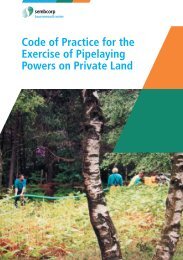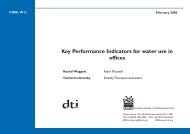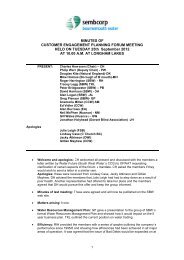New Forest - Sembcorp Bournemouth Water
New Forest - Sembcorp Bournemouth Water
New Forest - Sembcorp Bournemouth Water
- No tags were found...
You also want an ePaper? Increase the reach of your titles
YUMPU automatically turns print PDFs into web optimized ePapers that Google loves.
occurs in the poached muddy pools and is confined in Englandto the <strong>New</strong> <strong>Forest</strong> area.The unimproved meadows in and around the <strong>Forest</strong> havesimilarities with the acid to neutral grasslands within the Open<strong>Forest</strong>. The frequent spring-lines and infertility of the soilshave hindered agricultural improvement and these meadowcommunities are now rare or scarce in England. The mainvegetation types are herb-rich, permanent pastures on the drierbrown earths and stagno-gleys and a complex range of wet acidgrasslands on gleys and peats. The former could be described asthe typical grassland of grazed hay-meadows usually dominatedby common bent Agrostis capillaris and red fescue Festucarubra but containing a high proportion of herbs. The characterof the wet grassland is more complex. Moderately-grazed, rushdominatedstands are mostly dominated by sharp-flowered rushJuncus acutiflorus and accompanied by soft rush Juncus effususbut the other associates can be quite diverse. Lightlygrazedgrassland dominated by Molinia caerulea is especially variablewith both heathy, fen meadow and mire communities present.Pony-grazed grasslands lack any tall dominants and consistof a species-rich mixture of velvet bent Agrostis canina andsedges, much like the wetter Open <strong>Forest</strong> lawns. Within thesevegetation types there are pockets containing diverse herbrichcommunities. Very dry soils, for instance, support parchedacid-grassland which is typically hard-grazed and disturbedand provides suitable habitat for spring annuals such assubterranean clover Trifolium subterraneum. In contrast thewettest parts of spring-lines often support mire communitiestypical of the Open <strong>Forest</strong> with Sphagnum species dominant andscarce plants present such as brown beak-sedge Rhynchosporafusco. Much rarer are the baserich mire communities whichoccur in close juxtaposition with acid communities such as thesmall, marshy flushes at Upper Pennington Common.The <strong>Forest</strong> contains about 90 clearly separable valley mires, orfen, within about 20 different valley systems. This is thought tobe more than survive in the remainder of Britain and WesternEurope. This suite of mires sits within a relatively unpollutedcatchment and for this reason the greater part of the <strong>New</strong><strong>Forest</strong> has been designated as an internationally importantwetland, a Ramsar site. The mires receive the products ofleaching from the higher ground and are thus comparativelybase-enriched. Structurally they comprise a distinctivesequence of plant communities arranged laterally to the axisand exhibiting increased enrichment from the outer margin tothe centre. Similarly, the mires tend to become progressivelybase-enriched with progress downstream from the valley head,and this also influences the complex arrangement of plantcommunities. The zonation from enriched fen along the axesof many mires, to acid mire at the outer margins, gives riseto a great diversity of plant species. The richest mires have inexcess of 150 species including many locally distributed andrare plants. Slender cottongrass Eriophorum gracile (RDB)*(Sch.8*)** is confined in England to sites in the <strong>New</strong> <strong>Forest</strong> andone in Surrey. The list of nationally scarce plants found on miresand their heathy margins include pillwort Pilularia globulifera,bog orchid Hammarbya paludosa, bog hair-grass Deschampsiasetacea, marsh gentian Gentiana pneumonanthe, marshclubmoss Lycopodiella inundata, brown beak-sedge and marshfern Thelypteris palustris*.Of the many ponds within the <strong>Forest</strong> the less acidic pondssupport important populations of amphibians, includingthe rare great crested newt Triturus cristatus (Sch.5)**. Thewetland habitats collectively form probably the most importantsingle suite of habitats for dragonflies Odonata in Britain.Twenty-seven species breed in the <strong>New</strong> <strong>Forest</strong> including therare southern damselfly Coenagrion mercuriale (RDB)*. Thetemporary ponds that dry out in the summer provide idealconditions for some specially adapted invertebrates includingfairy shrimps Chirocephalus diaphanus and one such pond isthe only known British locality for the tadpole shrimp Triopscancriformis both (RDB)* (Sch.5)**.The plant community associated with the streams is restrictedalmost exclusively to the <strong>New</strong> <strong>Forest</strong>. (The only other stream ofthis type is the River Fowey on Bodmin Moor.) This is because ofthe combination of nutrient-poor acid waters and outcrops ofneutral-enriched soils. The Lymington River is the largest streamsystem within the <strong>Forest</strong> showing all the typical characteristics.The tributary known as the Ober <strong>Water</strong> is recognised in theNature Conservation Review as a lowland base-poor streamwith a very diverse flora. Surveys of the <strong>Forest</strong> streams haverecorded twenty of the fifty-four British species of fish and awide variety of invertebrates. Some streams are used by otters, aspecies which has declined and which is fully protected throughSchedule 5**.The <strong>Forest</strong> supports populations of nine rare and twenty-fivenationally scarce vascular plants*. Of the rare plants five havebeen mentioned above. Dorset heath Erica ciliaris occurs at twolocations and the wild gladiolus Gladiolus illyricus (Sch.8)**,which is confined to the <strong>New</strong> <strong>Forest</strong> in Britain, is present inmany of the bracken stands where it is normally associated withbluebells and wood anemones. Heath lobelia Lobelia urens isonly found at one locality, as is the early gentian Gentianellaanglica which occurs in association with imported chalk!The <strong>New</strong> <strong>Forest</strong> supports nationally important breedingpopulations of birds as listed in Annex 1 of the EU Directive onthe Conservation of Wild Birds including, nightjar Caprimulguseuropaeus, woodlark Lullula arborea, Dartford warbler Sylviaundata, and kingfisher Alcedo atthis. The <strong>Forest</strong> also supports awintering population of hen harrier Circus cyaneus which is alsolisted on Annex 1. Other breeding birds include an assemblageof waders comprising lapwing Vanellus vanellus, redshankTringa totanus, curlew Numenius arquata, snipe Gallinagogallinago and ringed plover Charadrius hiaticulata which alldepend to a great extent on the <strong>Forest</strong>’s wetland habitats.Populations of all Britain’s native reptiles are present in the <strong>New</strong><strong>Forest</strong> including sand lizard Lacerta agilis (Sch.5)* and smoothsnake Coronella austriaca (Sch.5), which both occur in suitablelocalities throughout the heathland.The wide range of habitats within the <strong>New</strong> <strong>Forest</strong>, and its largesize, make it an important site for populations of several groupsof invertebrates. Of the 2,500 species of British butterflies andmoths Lepidoptera, nearly half have been recorded from the<strong>Forest</strong> and over a third of the British species of beetle havebeen recorded as well as many species from other invertebrategroups. Many of these species are recorded in the Red DataBook and even more are considered notable. For some of these14 <strong>New</strong> <strong>Forest</strong> – Guidelines for maintenance operations within sensitive areas
















